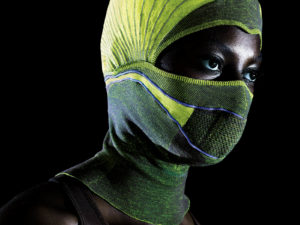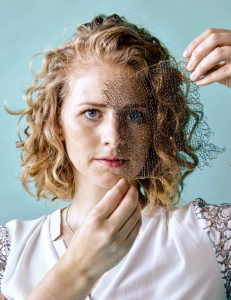
Manufacturers of smart fabrics are looking for new, novel textile substrates.
A key takeaway from the Smart Fabrics Program and E-Textiles Workshop at the 2017 IFAI Expo was the symbiotic relationship between smart technologies and the development of suitable textile substrates to facilitate the desired function.
While the fashion apparel business has become increasingly commodity-driven, smart fabrics require the use of specialty yarns and form factors that are custom-engineered to work together with unique physical or chemical technologies in order to create a responsive textile product.
“What we are doing now is merging two industries,” says Eva Osborne, vice president of research and innovation for smart textile incubator Significant Difference LLC, located in New Holland, Pa., and lead E-Textiles Workshop host at IFAI Expo. “We need to have a conversation.”
This presents both a challenge and an opportunity for textile suppliers, forcing them to step away from the practice of bulk production and to recalibrate their business toward value-added, customized products. As a result, the presenters and exhibitors of advanced textiles at IFAI Expo focused more on creative solutions and disruptive ideas and less on exhibiting existing products.
From the ground up
Connie Huffa, president and co-founder of Fabdesigns, a textile incubator and innovation center for smart fabrics in Malibu, Calif., explains, “We build fabric along with the product. Smart textiles need to be designed from the polymer forward—from the ground up.”
Specialized polymers and unique yarn configurations are a critical building block for smart textiles. Unifi Inc., a producer of textured synthetic yarns based in Greensboro, N.C., has diversified in order to become a solution provider, according to Meredith Boyd, global business development manager. “The days of running a continuous polymer line are gone,” Boyd says. For example, Unifi offers XS Dynamic Tunability polyester yarns, featuring customized modification of individual filament cross-sections to achieve various properties.
Metallized fibers that are able to conduct or resist an electric charge are at the heart of e-textile innovation. At MacDermid Enthone, an electronic solutions provider based in Maple Plain, Minn., silver, copper, nickel, stainless steel and carbon can be plated or wrapped around textile fibers to provide electrical, thermal and physical performance properties. Variations in the materials and metallization technologies allow these properties to be fine-tuned.
At Marubeni Electro-Yarn, based in Japan, conductive thread coated with multi-walled carbon nanotubes is coupled with 1.2mm spherical solar cells and woven into emerging harvesting textiles.
Shape memory and super-elastic polymers, auxetic yarns and shape memory alloys such as nickel titanium lend new properties to yarns and textile structures that we are only just learning to exploit.
Thermo-reactive mineral-infused yarns, such as Celliant® by Calif.-based Hologenix LLC, convert body heat into infrared energy, said to regulate body temperature and boost oxygenation of the blood, improving well-being.

Smart fabrics, smart machines
Another challenge facing today’s innovators of smart fabrics is finding appropriate machinery—and the knowledge base needed to create unique substrates. “Most knitting machines are made for apparel,” Huffa says. Fabdesigns turned to flat knitting machines to create technical knit structures for their clients in the footwear, military, medical and aerospace fields.
Germany-based Stoll GmbH showed a portable solar charger at IFAI Expo that’s comprised of a printed organic photovoltaic module inlaid in a tubular knit, with a knitted-in electric circuit. With its CMS ADF technology, Stoll machinery is exploiting the potential for smart technologies in performance knitwear. The latest flatbed machines can create unique structures such as 3-D, compression, plating and weave-in applications, and can knit circuits and conductive yarns into the fabrics precisely where they are needed.
Stoll’s Performance+ collection illustrates innovative ideas for the automated production of fully fashioned, one-piece smart knitwear. A runner’s balaclava and sports bra are knit with 3-D goring technology and Stoll-ikat plating® to create heated mesh structures, body-mapping and pockets for removable batteries or electronic chips.
The capabilities of the Stoll CMS ADF machines also have industrial applications. For example, the printed organic photovoltaic modules mentioned earlier are riveted for conductivity. The modules are connected with thin conductive threads, and the lightweight structure folds to the size of one module for storage and transport.
Talking the talk
Given the proprietary nature of smart and e-textile product development, most textile companies on the Expo floor left specific products back in the lab. But it was clear that they were “talking the talk.”
Supertex Inc., a North Carolina-based warp-knitter that specializes in geosynthetics, automotive, packaging and mesh materials, admitted to knitting with some conductive yarns and carbon fibers per customer specifications.
Evolving from parent company and denim innovator DNA Textile Group, DNA Technical Fabrics is bringing its woven textile expertise to the technical and industrial markets. The company is branching out into textiles for filtration, composites, transportation, medical and the military; its apparel customers are looking to integrate performance and technology into their fabrics as well.
“When we tell our apparel customers that we are making technical fabrics, their eyes light up,” says Monte Galbraith, president of DNA Textile Group based in Columbus, Ga.
New York-based knitter and weaver Gehring-Tricot/Tweave LLC has been ahead of the smart textiles curve for some time, focusing on 3-D spacer and stretch fabrics for a diverse range of markets such as medical, sports, safety, aerospace, apparel and the military. The company’s full range of equipment includes fine-gauge and electronic jacquard, circular knit machines; tricot, raschel, double-needle bar and simplex machines; and stretch weaving.
“Gehring is trying to anticipate the need for growth in the e-textile area. We’ve learned how to adapt our textile machines to nontraditional applications through yarn and structure innovation,” says Bill Christmann, vice president of sales and marketing for the company. “What we’ve done to communicate in the technical sector is to bring in engineering people who speak the language and incorporate these people into our staff.”
Smart mechanical fabrics
At the University of Minnesota, Julianna Abel, assistant professor, department of mechanical engineering, works with knitted structures using shape memory alloys to create smart mechanical textiles that perform work by moving and changing under stress.
Shape memory alloys have enormous potential as smart textile actuators, exhibiting a mechanical or dimensional change in response to a stimulus, such as a temperature change or electrical current.
Due to their loop structure, knitted textiles show more deformation under stress than woven fabrics. By altering the stitch pattern—for example, jersey, reverse (purl), rib or grid—the movement of shape alloy knits can be tailored. The maximum force and work of the deformation is dependent on the diameter of the wire (the smart alloy), with nickel titanium offering a super-elastic spring property.
Abel demonstrated the mechanical efficacy of such knitted structures in a project with a University of Minnesota theater production. Light, compact, repeatable “morphing wings” for an actor were created from a shape memory actuator, stimulated to open by resistive heating.
The concept has potential applications in compression garments or as super-elastic relaxation devices for a type of heart failure called HFpEF, in which the left ventricle shows an increase in stiffness and impaired relaxation after pumping. Smart mechanical knitted structures may also hold potential for aerospace applications.
Get smart
“Weaving, knitting and knotting haven’t changed in thousands of years,” Eva Osborne reminds us. Yet in other industries new technologies are constantly invented and existing ones are radically transformed. Meeting the technical, industrial and consumer needs for future textiles requires all sectors of the industry—from polymer to production—to “get smart.” It’s good to see progress being made.
Debra Cobb is a freelance writer based in Greensboro, N.C., with extensive experience in the textiles industry. She is a regular contributor to Advanced Textiles Source, www.advancedtextilessource.com.
 TEXTILES.ORG
TEXTILES.ORG


